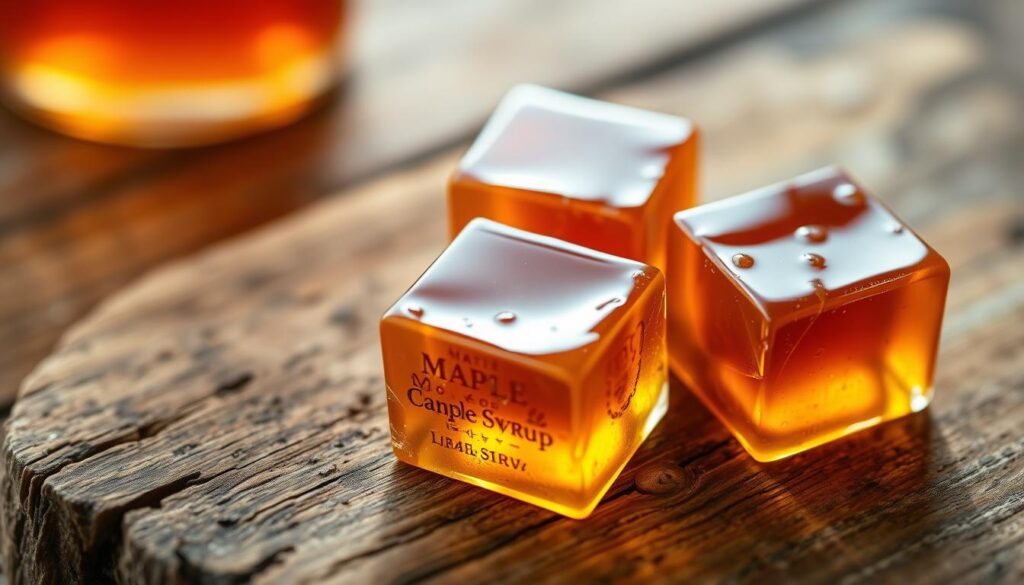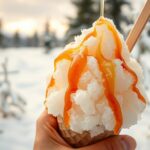Imagine turning maple syrup into easy-to-use cubes. These cubes change how we enjoy this classic sweetener. They keep the taste of traditional maple syrup but are easier to use.
Maple syrup cubes are a big step forward in enjoying natural sweeteners. They’re not like liquid syrup. They make it easy to measure, store, and use in many recipes.
These cubes are made carefully to keep the real taste of maple syrup. They offer sweet flavor without losing the special taste that maple syrup fans love. They’re great for both chefs and home cooks looking for a new way to enjoy maple syrup.
Creating maple syrup cubes is a big achievement in food tech. It solves storage problems while keeping quality high. Each cube is full of maple’s pure taste, making it a neat alternative to syrup bottles.
Food enthusiasts and kitchen innovators will love maple syrup cubes. They’re easy to add to recipes, drinks, and desserts. Their small size and exact measurements are perfect for any kitchen.
Understanding Maple Syrup Cubes: Nature’s Sweet Innovation
Pure maple syrup is a culinary innovation that changes how we use sweeteners. It turns liquid sweeteners into exciting solid forms. This process transforms natural maple syrup into maple syrup cubes, opening up new ways to cook.
The Science of Crystallization
Crystallization in pure maple syrup happens through sugar molecule interactions. When maple syrup is processed, its molecules change, forming stable shapes. This change depends on several factors:
- Sugar concentration
- Temperature control
- Precise cooling techniques
- Molecular bonding
Transformation from Liquid to Solid
Turning natural maple syrup into solid cubes needs careful attention. Sugarmakers control temperature and pressure to form sugar crystals. This careful process keeps the rich flavor of the original syrup in each cube.
Chemical Properties of Solidified Maple Syrup
Solidified maple syrup is chemically stable. The crystallization process keeps its nutrients and antioxidants. These cubes have the same minerals and flavor as the original syrup, making it a special treat in cooking.
The Rich History of Maple Syrup Production
The story of maple syrup starts with Native Americans. They first found the sweet sap of maple trees. Before European settlers came, Native communities in Quebec and Ontario already knew how to make maple syrup.
Indigenous people had a smart way to make maple syrup. They made cuts in maple trees and used wooden tools to collect sap. Their traditional steps included:
- Identifying mature maple trees
- Creating precise cuts in tree bark
- Collecting sap in birch bark containers
- Boiling the sap using heated stones
When Europeans came, maple syrup production changed a lot. They learned from Native Americans and added metal tools and better boiling methods. By the 1800s, maple syrup was very important for rural areas.
| Era | Production Method | Key Innovations |
|---|---|---|
| Pre-Colonial | Indigenous Traditional Methods | Wooden Tools, Stone Boiling |
| 19th Century | Settler Adaptation | Metal Taps, Large Kettles |
| 20th Century | Mechanized Production | Vacuum Systems, Industrial Evaporators |
The history of maple syrup shows how technology and culture have grown together. Canadian maple syrup is a symbol of the hard work of many sugarmakers. They turned a natural gift into a beloved food around the world.
Pure Canadian Maple Syrup: The Perfect Base for Cubes
Canadian maple syrup is a culinary treasure known for its quality and flavor. Turning it into maple syrup cubes is a journey. It starts with understanding the unique qualities of this natural sweetener.
The quality of maple syrup cubes depends on the syrup’s original characteristics. Canadian producers have a detailed grading system. This ensures that the syrup is always top-notch.
Exploring Maple Syrup Grades
Maple syrup grades show the syrup’s depth and complexity:
- Grade A Light Amber: Delicate flavor, perfect for subtle sweetening
- Grade A Medium Amber: Balanced taste with robust maple notes
- Grade A Dark Amber: Intense maple flavor ideal for baking
- Grade B: Strongest maple character, best for cooking transformations
Regional Flavor Variations
The terroir of Canadian maple forests greatly affects the syrup’s taste. Places like Quebec, Ontario, and New Brunswick have their own unique flavors. These are shaped by:
- Soil composition
- Tree age
- Climate conditions
- Harvesting techniques
Seasonal Impact on Maple Syrup Quality
The time of year syrup is harvested greatly affects its quality. Early spring sap makes lighter, more delicate syrups. Later harvests produce darker, more complex flavors. These changes impact the taste and quality of maple syrup cubes.
The magic of maple syrup lies in its ability to capture the essence of Canadian forests in a single drop.
Manufacturing Process of Maple Syrup Cubes
Turning liquid maple syrup into cubes is a precise process. It starts with high-quality Canadian maple syrup. This syrup is then crystallized in a special way.
The making of maple syrup cubes goes through several key steps:
- Initial syrup concentration and purification
- Temperature-controlled crystallization
- Molding and shaping
- Quality control and packaging
Special machines are used to turn syrup into solid cubes. The crystallization needs the syrup to cool slowly, between 70-75°F. This helps the sugar molecules form solid cubes.
| Production Stage | Key Process | Duration |
|---|---|---|
| Syrup Preparation | Filtering and concentrating | 2-3 hours |
| Crystallization | Controlled cooling | 4-6 hours |
| Molding | Cube formation | 1-2 hours |
Maple syrup cubes keep the natural taste of liquid maple syrup. The making process ensures each cube is full of sweetness. This makes them great for cooking and baking.
Quality is very important in making maple syrup cubes. Tests are done to check the sugar, consistency, and purity. This ensures the cubes are top-notch for those who buy them.
Health Benefits of Natural Maple Syrup Products
Natural maple syrup products are more than sweet treats. They are packed with essential minerals and health-boosting compounds. This makes them a great choice for those who care about their health.
Maple syrup cubes are incredibly nutritious. They have minerals that help keep you healthy, like:
- Zinc for immune system support
- Manganese for bone health
- Calcium for strong bones
- Potassium for heart function
Nutritional Profile of Maple Cubes
Maple syrup cubes are a concentrated source of nutrients. They come in a convenient cube form. Researchers have found that these cubes have many health benefits.
Antioxidant Properties
The antioxidants in natural maple syrup are impressive. Dark maple syrup has over 24 different antioxidants. These help protect cells and reduce inflammation.
- Phenolic acids
- Flavonoids
- Lignans
- Abscisic acid
Comparing Sugar Alternatives
Maple syrup cubes are a standout among sugar alternatives. They offer real nutritional benefits, unlike artificial sweeteners. They also have a lower glycemic index than refined sugars.
Maple syrup cubes are a pure, minimally processed sweetener. They add flavor and nutrition to your diet.
Creative Ways to Use Maple Syrup Cubes in Cooking
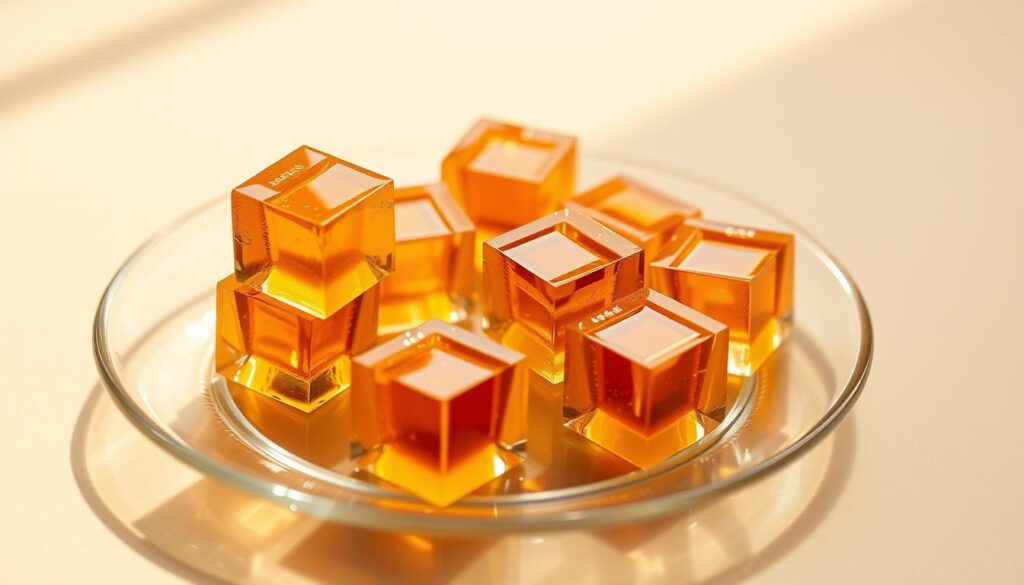
Maple syrup cubes change how we add sweetness to our food. They give us precise control over flavor and are easy to use. This is great for both home cooks and professional chefs.
There are many fun ways to use maple syrup cubes in cooking:
- Baking: Melt them into cake batters, cookie doughs, and bread for sweet flavor
- Beverage Enhancement: Add them to hot drinks like coffee, tea, and cocktails for flavor
- Glazing Meats: Make glazes for roasted chicken, pork, and salmon by melting them
- Dessert Decoration: Use them as fancy garnishes for ice cream, pancakes, and waffles
Professional chefs love maple syrup cubes for their exactness. They offer a precise way to add flavor, unlike liquid syrup. They melt fast, making them easy to mix into dishes.
Breakfast lovers will enjoy maple syrup cubes too. Sprinkle them on oatmeal, blend into smoothies, or top French toast. They make simple breakfasts taste like gourmet meals.
Pro tip: Store maple syrup cubes in cool, dry places to keep them fresh and prevent melting.
Organic vs. Conventional Maple Syrup Cubes
The world of natural maple syrup has two main types: organic and conventional. Knowing the difference between them shows how they affect our health, the environment, and the syrup’s quality.
Organic maple syrup is made with care for the environment. The producers follow strict rules to keep forests healthy and use fewer chemicals.
Certification Standards for Organic Maple Syrup
To get organic certification, producers must meet high standards. These standards are more than what regular maple syrup needs:
- No synthetic pesticides or fertilizers in forest management
- Sustainable forest preservation practices
- Regular third-party inspections
- Strict traceability of production processes
Environmental Impact Considerations
Organic maple syrup production is very good for the environment. It helps keep forests diverse, healthy, and reduces carbon emissions. This is better than traditional methods.
The main differences between organic and conventional maple syrup cubes are:
| Aspect | Organic Maple Syrup | Conventional Maple Syrup |
|---|---|---|
| Chemical Use | Prohibited | Permitted |
| Forest Management | Sustainable practices | Standard techniques |
| Certification | USDA Organic | No specific certification |
Choosing organic maple syrup cubes helps support sustainable farming. It also means you get a natural product without artificial additives. People who care about the environment and their health often choose organic.
Storage and Preservation Tips for Maple Cubes
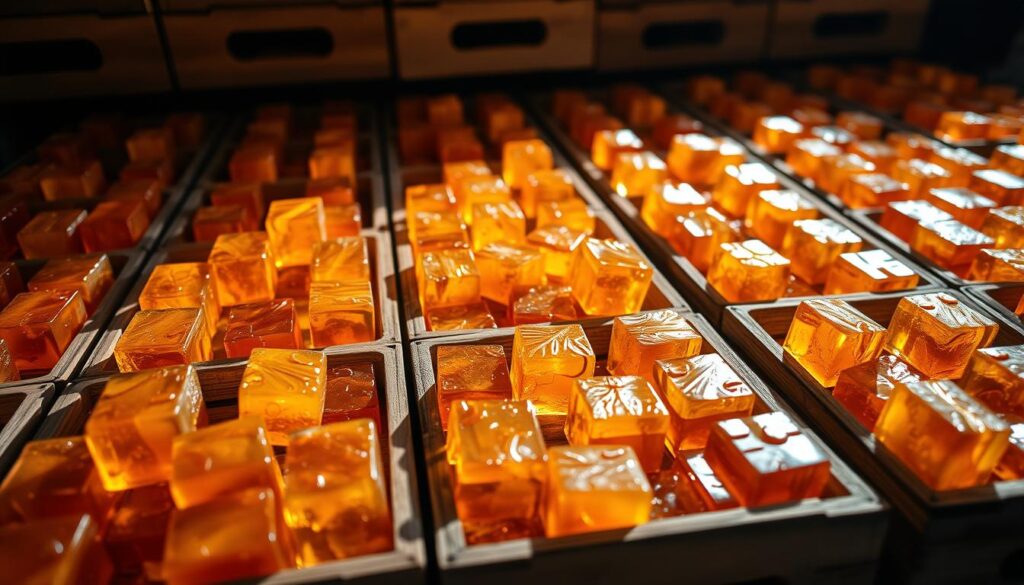
Storing maple syrup cubes right is key to keeping their quality and taste top-notch. The right storage keeps these treats fresh and full of flavor for a long time.
Temperature is very important for keeping maple syrup cubes fresh. Sugarmakers suggest specific conditions to protect these sweet treats.
- Store maple syrup cubes in a cool, dark place
- Maintain consistent temperature between 50-70°F
- Use airtight containers to prevent moisture absorption
- Keep away from direct sunlight and heat sources
Moisture is the biggest enemy of maple syrup cubes. Too much humidity can make them crystallize or change their texture.
| Storage Condition | Recommended Practice | Impact on Maple Syrup Cubes |
|---|---|---|
| Humidity Level | Below 60% relative humidity | Prevents moisture absorption |
| Container Type | Glass or food-grade plastic | Maintains cube integrity |
| Storage Duration | Up to 12 months | Ensures peak flavor preservation |
Pro tip: Always use clean, dry utensils when handling maple syrup cubes. This helps prevent contamination and keeps them fresh longer.
Refrigeration isn’t always needed for maple syrup cubes. But, it’s good if your home is warm or humid. Let the cubes come to room temperature before using them to get the best texture.
Best Maple Syrup Cube Brands in the Market
Finding the top maple syrup cube brands means looking at quality, taste, and value. There are many great options for those looking for the best maple syrup cubes. Each brand has its own special qualities that suit different tastes and cooking styles.
Quality Indicators for Premium Maple Syrup Cubes
High-quality maple syrup cubes have certain key features:
- Color intensity and consistency
- Crystallization uniformity
- Purity of ingredients
- Organic certification
- Flavor complexity
Price Comparison Guide
When choosing a maple syrup supplier, price matters. Here’s a comparison of some brands and their prices:
| Brand | Price Range | Quantity | Certification |
|---|---|---|---|
| Vermont Sugar Works | $12-$15 | 8 oz | Organic |
| Canadian Pure Maple | $10-$13 | 6 oz | Grade A |
| Adirondack Gold | $14-$17 | 10 oz | Small Batch |
It’s not just about the price. Think about the value you get from each brand. Some brands might be worth a bit more for those who love maple syrup.
Sustainability in Maple Syrup Production
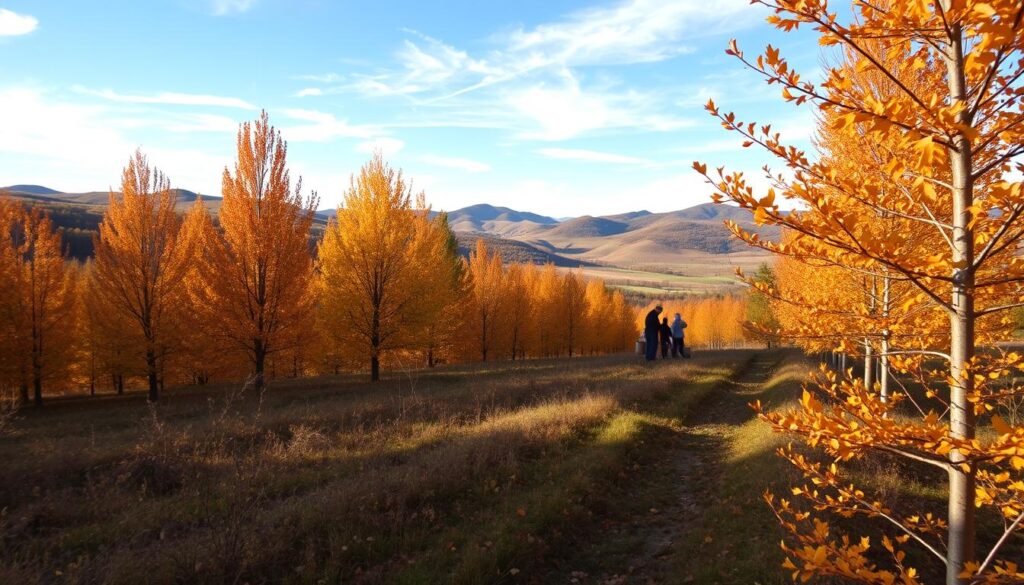
Sustainable maple syrup production is key to keeping forests healthy and syrup quality high. Sugarmakers in North America are dedicated to protecting the environment. They use new ways to harvest sap without harming the trees.
The main ideas of sustainable maple syrup production are:
- Protecting forest biodiversity
- Implementing responsible tapping practices
- Minimizing environmental impact
- Preserving tree health
Quebec is a leader in sustainable maple syrup, making about 70% of the world’s supply. Family-owned sugar bushes use old and new methods together. This keeps the trees healthy and sap flowing for years.
Maple forests are also important for fighting climate change. They soak up carbon dioxide from the air. By keeping these forests safe, sugarmakers help the planet and make great syrup.
Getting organic certification is another step towards sustainability. It means no harmful chemicals and careful checks on the environment. This ensures maple syrup is made in a way that’s good for the planet and the trees.
Seasonal Availability and Peak Harvesting Times
Canadian maple syrup production has a unique seasonal rhythm. This rhythm greatly affects when we can get this natural sweetener. The maple syrup harvest is a careful balance between nature and the skill of sugarmakers.
The maple syrup season usually happens in late winter and early spring. Sugarmakers watch the temperature closely. They wait for the sap to flow in maple trees, which is the best time to harvest.
Regional Harvest Calendar
Each region has its own maple syrup production schedule. Here’s a calendar showing when the main areas harvest:
| Region | Peak Harvest Months | Average Production |
|---|---|---|
| Quebec | March-April | 70% of global production |
| Ontario | Late February-Mid April | 25% of global production |
| Vermont | March-Early April | 5% of North American production |
Best Time to Purchase
Maple syrup lovers should buy it right after it’s harvested for the best taste. The best time to buy is:
- Right after the harvest season in your area
- Within 3-6 months of when it was made
- From local producers who are certified
Buying fresh Canadian maple syrup means you get the best flavor and quality. How it’s stored and quickly processed is key to keeping its great taste.
Maple Syrup Cubes vs Traditional Liquid Syrup
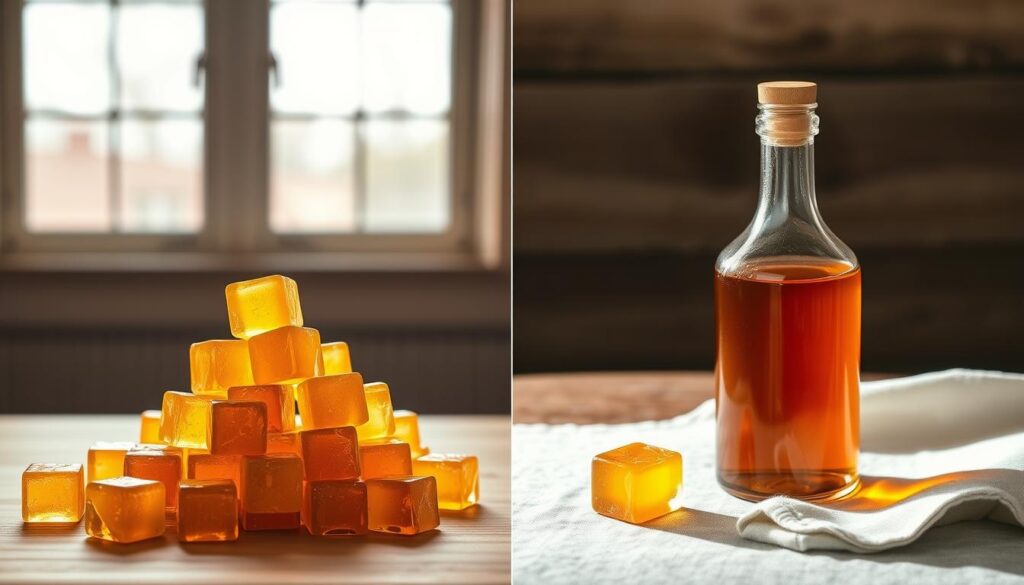
Pure maple syrup comes in different forms. Maple syrup cubes are a new choice compared to the traditional liquid syrup. They bring benefits for those who love cooking and want easy syrup options.
Maple syrup cubes and liquid syrup differ in several important ways:
- Portability and storage
- Precise measurement
- Shelf stability
- Culinary applications
Maple syrup cubes are great for people on the go or outdoors. They don’t spill like liquid syrup and are lighter to carry. Chefs like them because they make it easy to measure syrup exactly for recipes.
| Characteristic | Liquid Syrup | Maple Syrup Cubes |
|---|---|---|
| Portability | Bulky containers | Compact and lightweight |
| Measurement Precision | Challenging | Easy and accurate |
| Storage Requirements | Refrigeration recommended | More stable at room temperature |
The taste of maple syrup cubes is just as good as the liquid syrup. Chefs and home cooks can easily swap them in recipes. They get the same rich, real maple flavor.
Choosing between maple syrup cubes and liquid syrup depends on what you prefer and need in cooking. Both give the sweet taste of pure maple syrup. Cubes offer more convenience and flexibility.
International Market and Export Regulations
The global market for maple syrup products has grown a lot in recent years. As a maple syrup supplier, knowing export rules is key to success.
Canadian maple syrup producers lead the global market. They follow strict rules to ensure quality and authenticity. Countries buying maple syrup must meet high standards to protect consumers and keep the sweetener’s good name.
- Export certification requirements vary by destination country
- Quality control measures protect maple syrup product integrity
- Traceability documentation is mandatory for international shipments
The United States is a big market for maple syrup, with a lot coming from Canada. Regulatory agencies watch maple syrup imports closely to keep food safe and follow trade rules.
Key export markets include:
| Country | Import Volume | Key Regulations |
|---|---|---|
| United States | 65% of global imports | FDA food safety standards |
| European Union | 15% of global imports | Strict organic certification |
| Japan | 10% of global imports | Detailed ingredient tracing |
To grow globally, maple syrup suppliers need to focus on detailed documentation, quality control, and understanding trade rules.
DIY Guide: Making Maple Syrup Cubes at Home
Making maple syrup cubes at home is a fun cooking project. It turns pure maple syrup into tasty solid treats. This guide will show you how to make your own maple syrup cubes using simple steps and common kitchen tools.
Essential Equipment for Maple Syrup Cubes
To make maple syrup cubes, you need just a few tools. Here’s what you’ll need to start your maple syrup cube journey:
- High-quality pure maple syrup
- Silicone ice cube trays or candy molds
- Candy thermometer
- Saucepan
- Wooden spoon
- Parchment paper
Step-by-Step Crystallization Process
Turning liquid maple syrup into cubes needs careful temperature control and patience. Follow these steps closely:
- Select premium pure maple syrup
- Heat syrup to 235-240°F (soft-ball stage)
- Remove from heat and let cool without stirring
- Gently pour into silicone molds
- Allow complete crystallization at room temperature
Troubleshooting Common Challenges
Even skilled sugarmakers face problems when making maple syrup cubes. Here’s a quick guide to common issues:
| Issue | Solution |
|---|---|
| Soft or sticky cubes | Increase heating temperature slightly |
| Grainy texture | Avoid stirring during cooling process |
| Uneven crystallization | Use consistent mold temperatures |
“The art of making maple syrup cubes is a delicate dance of temperature and technique.” – Maple Crafting Experts
With practice, you’ll get better at making perfect maple syrup cubes. They’ll be a convenient, concentrated form of pure maple syrup.
Packaging Solutions for Commercial Producers
Choosing the right packaging is key for maple syrup suppliers. It affects how well the product stays fresh, looks to customers, and sells in the market.
Commercial producers need to think about a few important things when picking packaging for maple syrup cubes:
- Moisture resistance to keep cubes fresh
- Portion control to make it easy to use
- Eco-friendly materials for the planet
- Branding to stand out
There are different packaging materials, each with its own benefits for maple syrup cubes. Manufacturers look at how well it keeps the product fresh, its cost, and if it’s good for the environment.
| Packaging Type | Durability | Cost Efficiency | Environmental Impact |
|---|---|---|---|
| Biodegradable Containers | Medium | High | Low |
| Vacuum-Sealed Pouches | High | Medium | Medium |
| Glass Jars | High | Low | High |
Innovative packaging can really help maple syrup cubes sell better. It’s important to find a balance between keeping the product safe, making it look good, and being kind to the environment.
Today’s maple syrup suppliers know that packaging is more than just holding the product. It’s a way to show off the quality of the product and what the brand stands for.
Conclusion
Exploring maple syrup cubes shows how we enjoy this natural sweetener has changed. Natural maple syrup is a favorite in many North American kitchens. But maple syrup cubes offer a new way to enjoy it.
These cubes are easy to use and keep the real taste and health benefits of maple syrup. They come from places like Quebec and Vermont. Here, small farms make these cubes for us to enjoy.
Maple syrup cubes make cooking more fun and flexible. They let us add just the right amount to our dishes. This makes them perfect for breakfast or fancy recipes.
The future of maple syrup looks bright. New tech and a love for natural foods are helping it grow. Maple syrup cubes mix old traditions with new ideas, exciting everyone who loves food.
Using maple syrup cubes connects us to a long history of cooking. They’re not just a sweetener. They celebrate skill, natural ingredients, and the creativity of food makers.

